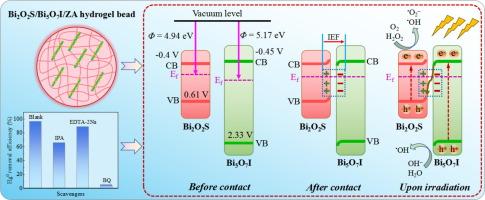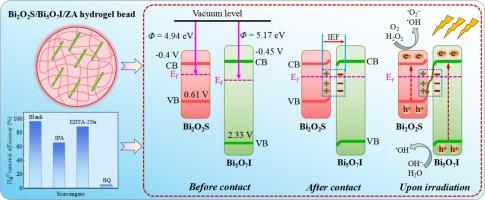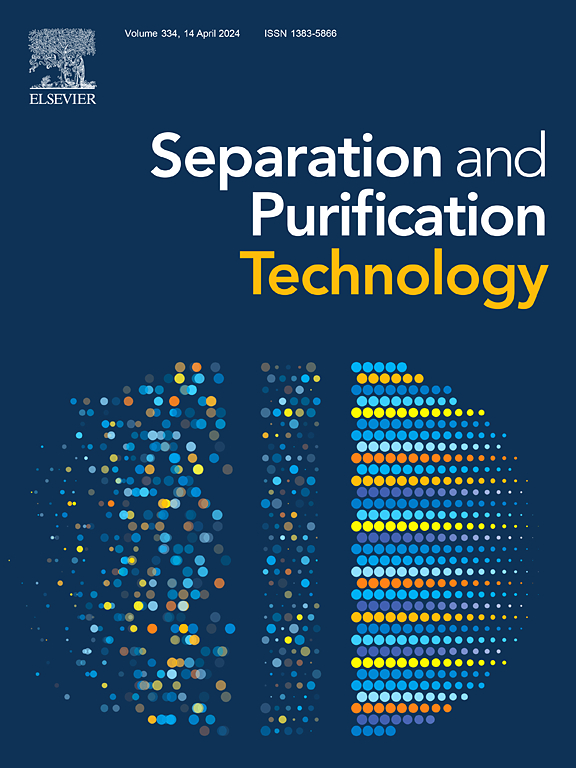制备可回收的 Bi2O2S/Bi5O7I/ZA 水凝胶珠,用于在 H2O2 存在下增强光催化除汞效果
IF 8.1
1区 工程技术
Q1 ENGINEERING, CHEMICAL
引用次数: 0
摘要
由于元素汞(Hg0)的毒性和生物蓄积性对公众健康和生态系统构成威胁,因此有效去除元素汞(Hg0)是一项全球性挑战。利用可见光驱动光催化剂的光催化技术有望去除汞。然而,从反应溶液中有效分离光催化剂粉末限制了其广泛应用。为了解决这个问题,我们首次报道了成功制备可回收 Bi2O2S/Bi5O7I/ZA 水凝胶珠,用于在 H2O2 存在下增强光催化去除 Hg0 的效果。为了解光催化剂的物理化学性质和光电性能,采用了 XRD、TEM、EDS、XPS、UV-vis DRS、PL 等表征技术。系列 BOSI 光催化剂的性能均优于单组分光催化剂,这归因于 Bi5O7I 和 Bi2O2S 之间形成了异质结。2-BOSI-ZA 珠与 H2O2 的耦合显示出良好的协同效应,其去除 Hg0 的效率按以下顺序排列:H2O2 + 2-BOSI-ZA < 2-BOSI-ZA + FSL < H2O2 + 2-BOSI-ZA + FSL。TPC、EIS 和 PL 测试证实,Bi2O2S 的引入有效地抑制了电荷载流子的重组。ESR 和自由基捕获实验表明,去除 Hg0 的主要物质是 -O2- 和 -OH。密度泛函理论计算表明,Bi5O7I 和 Bi2O2S 之间的内电场(IEF)有助于异质结的空间电荷分离。内电场导致了 Bi2O2S/Bi5O7I 界面的 S 型载流子转移机制,有利于 Bi5O7I 上的载流子分离,从而提高了光催化性能。这项研究为设计水凝胶光催化剂提供了进一步的启发,在汞污染控制领域,水凝胶光催化剂与氧化剂的结合具有卓越的活性。本文章由计算机程序翻译,如有差异,请以英文原文为准。


Fabrication of recoverable Bi2O2S/Bi5O7I/ZA hydrogel beads for enhanced photocatalytic Hg0 removal in the presence of H2O2
The effective removal of elemental mercury (Hg0) is a global challenge due to its toxicity and bioaccumulation threat to public health and ecosystems. Photocatalytic technology by visible light-driven photocatalysts is promising for Hg0 removal. However, effective separation of photocatalyst powders from reaction solution limits its widespread use. To solve the problem, we report for the first time the successful fabrication of recoverable Bi2O2S/Bi5O7I/ZA hydrogel beads for enhanced photocatalytic Hg0 removal in the presence of H2O2. Characterization techniques such as XRD, TEM, EDS, XPS, UV–vis DRS, PL, etc. are employed to understand the physicochemical properties and photoelectric performance of the photocatalysts. The serial BOSI photocatalysts all outperform the single component, which is attributed to the formation of a heterojunction between Bi5O7I and Bi2O2S. The coupling of 2-BOSI-ZA beads with H2O2 shows favorable synergistic effect, with Hg0 removal efficiency in the following order: H2O2 + 2-BOSI-ZA < 2-BOSI-ZA + FSL < H2O2 + 2-BOSI-ZA + FSL. TPC, EIS, and PL tests confirm that the introduction of Bi2O2S effectively suppresses charge carrier recombination. ESR and free radicals capture experiments demonstrate that the main species responsible for removal of Hg0 are •O2– and •OH. Density functional theory calculations exhibit that the internal electric field (IEF) between Bi5O7I and Bi2O2S contributes to the spatial charge separation of the heterojunction. The IEF leads to an S-scheme carrier transfer mechanism at the Bi2O2S/Bi5O7I interface that benefits the carrier separation on Bi5O7I, resulting in an enhanced photocatalytic performance. This work can provide further inspiration for designing hydrogel photocatalysts with an excellent activity in conjunction with oxidants in the field of mercury pollution control.
求助全文
通过发布文献求助,成功后即可免费获取论文全文。
去求助
来源期刊

Separation and Purification Technology
工程技术-工程:化工
CiteScore
14.00
自引率
12.80%
发文量
2347
审稿时长
43 days
期刊介绍:
Separation and Purification Technology is a premier journal committed to sharing innovative methods for separation and purification in chemical and environmental engineering, encompassing both homogeneous solutions and heterogeneous mixtures. Our scope includes the separation and/or purification of liquids, vapors, and gases, as well as carbon capture and separation techniques. However, it's important to note that methods solely intended for analytical purposes are not within the scope of the journal. Additionally, disciplines such as soil science, polymer science, and metallurgy fall outside the purview of Separation and Purification Technology. Join us in advancing the field of separation and purification methods for sustainable solutions in chemical and environmental engineering.
 求助内容:
求助内容: 应助结果提醒方式:
应助结果提醒方式:


